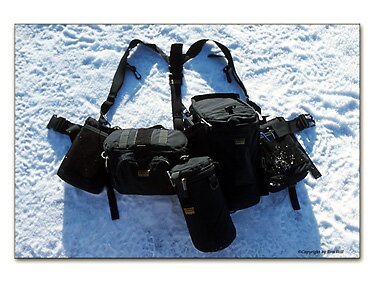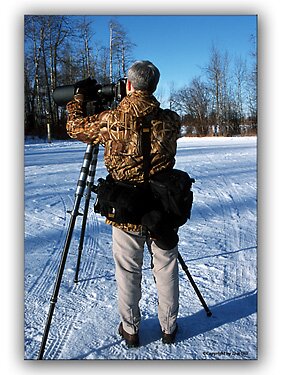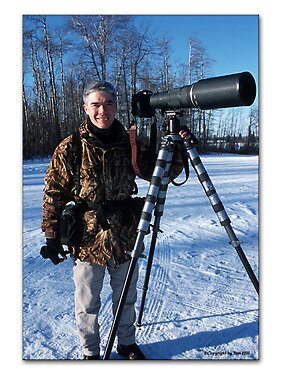

All Images And Text On This Site Are Copyright 1999-2001
by
Thomas D. Hill Jr.

| ABOUT KEIKO |
| WHAT'S NEW |
| THE KEIKO GALLERY |
| EQUIPMENT |
| IMAGE OF THE MONTH |
| ARTICLE OF THE MONTH |
30 May 01
One of the easiest mistakes made when acquiring new equipment is failure to consider how to store all that multi-thousands of dollars of stuff. Sure, you may think you only have to make a bit more room in your existing bag for that new lens. Yeah, this may work most of the time, but sometimes no amount of wishing is going to prepare you for the trauma of choosing among the thousands of camera bags on the market to figure out which one will work best for you. I know I've had troubles in the past and I wouldn't expect less from anyone else, no matter their experience. You may be like me in most cases. I'm a guy who collects bags on a whim to just add to his collection. The issue is how much is enough and why didn't you just get the right bag in the first place. First a couple of notes. I do not purchase things that will only last a couple of outings. Even though I'm planning only minimal use of a particular bag for a specific purpose, a lifetime can be significantly long. Might as well get something that will last that long.
I'm a big fan of accessory belts. I like the kind of thing that will allow a guy to carry most of his equipment around his waist and away from his shoulders. There are many different companies that make these things. The most popular are Lowe Pro and Kinesis Gear. I settled on Kinesis. Okay, there were many reasons why I picked this company, but the most important was its gear is extremely easy to reconfigure. Unlike Lowe Pro, Kinesis can easily be re-adjusted to include any amount of additional lens cases and stuff. The beauty of these belts is they not only carry your gear with minimal effort, they also allow easy access. Most backpack camera bags do not allow access while they're being worn. That means you have to routinely stop doing whatever you're doing whenever you want to change a lens. "Hold up Mr. Animal, I have to drop my backpack to get to that lens to shoot your portrait. Hold on there!" Why does this sound less than perfect? Another conventional thing to do is to use one of those traditional "over the shoulder" style camera bags that do everything they can to weigh down the shoulders and cause permanent back pain. No, I haven't followed my grandparents and picked up one of these things. I've instead blazed a new trail and acquired one of those new, swanky accessory belts like the gear that Kinesis makes.
So, what's so great about Kinesis equipment? Other than the fact it's superbly made and carefully thought out--the stuff is practically indestructible. You can practically hang your belt from a tree over a cliff and confidently depend on it to keep from separating as you apply your entire weight. No, it's not a death-defying trick. It's just plainly very well made. This is no surprise since the designer is an active field photographer who has learned the ropes through lots of experience. Nothing like on-the-job learning to figure out what a guy likes and what he doesn't.
When I went to search for my new accessory belt, I knew I wanted something that not only protected my gear from the trials and tribulations of normal field work, but it also had to be something that could take the place of an expensive camera vest. Ready access was a requirement along with great protection. Kinesis gear seemed to fit all my requirements.

1) Medium accessory pouch that carries all my film.
2) Multi-lens pouch that carries several tools (cleaning stuff and such), my teleconverters, and a 24mm f/2.8 lens.
3) Medium lens pouch that's connected to a camera case connected to the belt. It carries my SB-28 flash and flash accessories such as the flash extender and modified SC-17 remote cord.
4) Long lens camera case that is large enough to carry my F5 with 80-200 f/2.8 AF-S attached (hood in stored position).
5) Large accessory pouch that carries my note pad, writing tools, plastic trash bag (for those sudden down pours).
The whole configuration is topped off with suspenders to further add to the belt's stability and to allow limited use while the belt buckle isn't connected.


You'll notice it's very easy to walk or hike around with this setup. Like most well-designed backpacks, the weight of the gear is held by my waist and hips versus depending on my shoulders like those over-the-shoulder camera bags and some backpacks. What you see is really the best of many worlds, and it can replace expensive padded camera vests and other camera bags. Sort of killing several birds with one stone, if you will.
Okay, I haven't totally given up on camera backpacks. I just don't like to carry them out in the field during normal use. I still use them for storage and general transportation, but I don't normally use them when my Kinesis gear is available. I have a Lowe Pro Nature Trekker to carry most of my less used--though really important--gear. I also use that bag when I'm traveling and pack it to its gills as take-on luggage.

There you have it. My camera bags and how I carry my equipment in the field. It's a long discussion but well worth it because the topic is so important. There's nothing like a pain in the neck--or shoulder, or arm, or waist...--to make field work unenjoyable. I've put a lot of thought into my equipment, and I've placed the same importance on how I carry it. It's a good system and if I change things, you'll be the first to find out.
Cheers
Tom